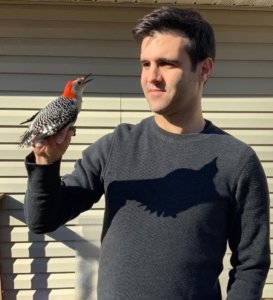- How did you get to where you are now, in terms of your education and training in science?
- I did my undergraduate at DePaul University in Chicago in Psychology and Biology. I then went on to do a Masters in Biomedical Science with a specialty in Neuroscience at Florida Atlantic University. From there I worked with Dr. Juan Dominguez at University of Texas at Austin for my PhD in Behavioral Neuroscience. After that I did my first postdoctoral fellowship at the University of British Columbia in Vancouver, Canada under Dr. Kiran Soma with a focus on neuroendocrinology. Finally, I worked with Dr. Matthew Fuxjager at Brown University in the Ecology and Evolutionary Biology department as a postdoctoral associate.
- What classes are you planning to reach this coming fall semester? Is there one in particular you are most excited about?
- I am teaching BIOL311 Biostatistics and POB I Lab this semester. I am really excited to teach the biostatistics course because statistics and dealing with data is one of the most interesting and rewarding aspects of research, but this is rarely conveyed in statistics courses. I hope to inspire students to truly understand the concepts behind statistics and to be able to analyze and understand data and research methods. I believe that this understanding is incredibly important even if they don’t continue on in a STEM field after they graduate, especially in this age of misinformation and sensationalism .
- Please describe your line of research
- My line of research has shifted dramatically since my PhD, but I have always looked at how hormones influence behavior and/or the brain. My planned lines of research at St. Mary’s are three-fold. First, I plan on working with local woodpecker species on the SMCM campus, banding them, and looking at how steroid hormones influence inter- and intra-specific socio-sexual interactions and fitness over many years. My second line of research will be to utilize woodpeckers as an animal model for traumatic brain injury. For example, I will be comparing how woodpeckers’ brains endure repeated hammering of their head (drumming). This communicative behavior occurs during the breeding season, so I will be looking at aspects like neuron death and birth, neuroimmune responses, and other molecular markers indicative of neuroprotection during the breeding and non-breeding seasons. Finally, I would like to continue my research looking at how sex steroids influence mate choice in a lekking species with extreme sexually dimorphism and amazing mating displays. I would like to set up a study-abroad or summer research opportunity where we go to Colombia and study bearded manakin (Manacus spp.) species to study these questions. That research probably won’t begin for another few years, however.
- What is your favorite type of bird and why?
- That’s a tough question. I would say that I have 3 favorite birds that I have worked with. First, is the Royal Flycatcher. They have this gorgeous crest but it’s only displayed when threatened. Second, I would say the Northern Bentbill. It’s a very small, olive green bird and blends in with the jungle, so it’s nothing spectacular to look at. But when you net one, they act so melodramatic and even after removing it from the net they’ll stay in your open palm for minutes. It’s really endearing. Finally, I would say the Blue Jay. When you have one in hand and they look you in the eye, you can just see the intelligence behind those black eyes. It’s quite stunning.
- Besides being a professor and researching, what else do you like to do for fun?
- I’ve been playing music since I was in middle school, so that is something that is essential to my life. I have 2 young kids and try to spend as much time as I can with them. Finally, I am a big Chicago Cubs (baseball) fan, so I love going to games. I’m glad that I ended up in a place where I can see them play a few times a year (sorry Nats fans). I have also decided to root for the Orioles and can’t wait to see Camden Yards.
- What else would you like the St. Mary’s community to know about you?
- I cherished my liberal arts undergraduate education, and I look forward to emulating the best parts of my experience at DePaul in my teaching, mentorship, and research with the students at St. Mary’s. I am also incredibly excited that I have the opportunity to help shape the future of the Biology department and develop the Neuroscience major with my colleagues.

